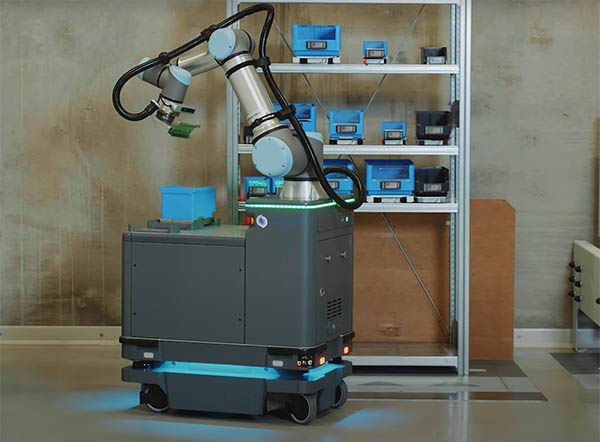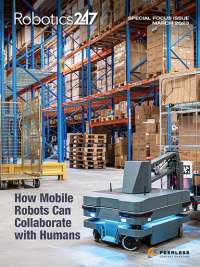Productivity declines, slow supply chains and the ongoing struggle to find and retain workers have all played roles in the rapid market adoption of autonomous mobile robots, or AMRs.
Despite the AMR industry being still in its infancy, warehouses, factories, and facilities of all sizes are already recognizing the benefits. They include bringing products to market faster, as well as deploying workers in more valuable and rewarding tasks than manual goods transportation.
Those advantages continue to push AMR deployments into increasingly challenging applications, from automotive and electronics manufacturing to third-party logistics (3PL) and consumer packaged goods (CPGs) providers.
To address the challenges of these sophisticated new applications, AMR vendors are constantly innovating to improve their robots’ performance and ease of use, allowing more robots to move efficiently and safely through complex traffic situations.
Five rapidly changing technologies are worth watching as they drive advancements and deployments of AMRs.
1. AI goes beyond the buzz to make AMRs smarter, safer
“Artificial intelligence” remains a confusing buzzword, inconsistently defined across industries and applications. But for AMRs, the technology means smarter robots that can teach themselves how to perform tasks that were previously difficult or impossible without expensive and time-intensive coding.
AI requires a significant amount of computational power, which is becoming more accessible for AMR developers. That allows developers to train robots to more quickly identify objects and situations.
Although it will be some time before robots can extrapolate outside of that training, a new generation of algorithms allows robots to be more effective at learning from what they experience to better detect and make intelligent choices in new situations.
Today, advanced AMRs rely on AI for capabilities such as identifying objects with greater precision and informing navigation for safe maneuvering through busy facilities, all with less power consumption.
And while huge jumps in AI capabilities are still to come, the autonomous behavior of AMRs—how they get from one point to another without truly knowing what goes on around them—will continue to improve.
2. 5G is coming – but maybe not as fast as anyone would like
Today’s mobile robots don’t require much infrastructure, so companies can easily start with one robot. However, as soon as facilities add more robots, they must have a way to connect and manage them. For now, at least, that depends on Wi-Fi. Unfortunately, most Wi-Fi infrastructures were not built for sharing data at this level.
Once 5G is widely deployed, its stronger and more robust IT infrastructure will be a game changer for AMRs, enabling companies to efficiently deploy and manage dozens or even hundreds of robots. 5G offers ultra-reliable and ultra-fast high-bandwidth communication, providing the stability to deploy multiple robots running without interruption.
In 2022, more companies will transition away from Wi-Fi connectivity to 4G, a big leap towards the stronger and more-robust IT infrastructure that 5G promises. Even with 4G, facilities will see better data connectivity, enhanced security, and a much higher overall quality of service than what is offered with traditional Wi-Fi.
As enterprises ultimately transition to 5G, which is built specifically to move even more data more quickly and more accurately, AMR performance will also make a huge leap, with faster, more precise decisions about the paths they take within the facility.
3. Interoperability, software advances support fleet management
For individual robots, improvements in sensor technology and connectivity advances such as 5G will help feed data into AMRs’ planning algorithms and software. This data is critical when navigating around facilities, enabling the robots to see any object around it or from above it. With the help of AI, advanced software instructs the robots on the tasks or programs to execute, aiding with path planning or collision avoidance.
Until recently, even two or three AMRs were considered an advanced set up. With facilities now deploying large numbers of AMRs, there’s a greater need for coordinating, controlling, and managing the fleet with a single internal logistics system.
From a Web-based interface, fleet management software improves the efficiency of AMR operations, enabling easy programming and control of the robots, including those with different top modules, hooks, or other accessories.
Once the programming phase is over, the system manages robot fleet priorities and selects the most suitable robot to the operation that needs to be carried out, based on position and availability. Fleet management software can also be integrated with other software, such as enterprise resource planning (ERP) and warehouse management systems (WMS).
As AMRs become integral to company operations, interoperability has become a driving force for new software advances. AMR vendors and users have teamed up to help enable interoperability across robot brands.
The MassRobotics AMR Interoperability Working Group is developing standards that will “allow organizations to deploy autonomous mobile robots from multiple vendors and have them work together in the same environment, better realizing the promise of warehouse and factory automation.”
Version 1.0 was released last May, and it was demonstrated in October 2021. The group includes Mobile Industrial Robots, AutoGuide, and others.
4. Cybersecurity protects critical data as automation uses more of it
Cybersecurity might not immediately come to mind when it comes to technologies advancing AMRs, but that’s changing. With AI, interoperability, and 5G wireless networks using company data much more extensively, robotics users need to pay attention to how that data is accessed and what AMR vendors are doing to secure it. This closely follows cybersecurity trends in the industrial sector, where threats have received much more attention recently.
The Colonial Pipeline hack in May 2021 is a prominent example of how disruptive industrial cyberattacks can be. Even though the automation industry is not currently seeing a significant increase in attacks, a concerning trend in the number and sophistication of supply chain attacks is worth close attention.
Cyber-physical systems are becoming increasingly interesting both to the security industry and to threat actors. While most attacks still target businesses’ IT infrastructure, threats to the operational technology (OT) devices are rapidly growing. New zero-day vulnerabilities in embedded devices are being identified at an increasing pace, and many are not yet patched.
This evolution of the threat landscape means businesses of all sizes need to step up their game regarding cybersecurity. Applying defense-in-depth and applying security best practices throughout the entire product lifecycle are cornerstones of creating secure products.
As part of this trend, AMR vendors need to take decisive actions towards ensuring customers are protected in an ever-evolving, interconnected world.
5. Lines are blurring between AMRs and automation
AMRs can transform the way companies handle internal logistics so they can be more productive and competitive. That means integrators and vendors are working closely with facility managers to help them take advantage of the advancements in material handling.
Small-payload applications—such as transporting raw materials to production, taking finished products to quality assurance, or even taking out the trash—are already being deployed in facilities worldwide.
More customers are asking for AMRs that can transport higher payloads, even replacing fully manned fork trucks or pallet lifters. In addition, mobile manipulators, with a collaborative robot arm mounted on mobile platforms, are also advancing as more companies want to move the cobot from one location to another to perform a wider range of tasks and gain higher value from the automation investment.
As companies reap the benefits of automation, they continue to see new opportunities, from the receiving dock, through the manufacturing floor, to the warehouse and shipping. With enhanced performance, security, and interoperability, the lines between traditional systems and AMRs will continue to blur.
Ongoing labor, supply chain, and productivity challenges will only increase the demand for affordable, efficient automation technologies. And while AMRs may represent a young industry, technology advancements and trends such as these are helping drive explosive growth in both capabilities and market adoption.
About the author
Matt Charles is sales director for the U.S. Midwest and Canada at Mobile Industrial Robots.
Article topics
Email Sign Up




















